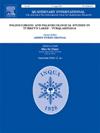Charcoal insights on the vegetation, climate and subsistence patterns at Wonderwerk Cave
IF 1.8
3区 地球科学
Q3 GEOGRAPHY, PHYSICAL
引用次数: 0
Abstract
Wonderwerk Cave is one of the most important archaeological sites in central southern Africa as it preserves multiple indicators of past environments, climates and human behavior. The cave has the potential to provide important palaeoenvironmental and palaeoethnobotanical information that can be applied to the less archeologically understood central southern African region. This study provides the vegetation and climate context of the interior southern African region during 2.3–0.5 ka BP by using charcoal from strata 2b and 3a of Wonderwerk Cave. The study also provides possible human-plant interactions during this time. A total of 90 charcoal fragments were studied under a microscope, their taxonomy determined, and the modern distribution of nearest living relatives utilized to determine the environmental conditions of the area in the past. A second method was applied by associating the physiognomic features of wood charcoal with the habitat. Both methods indicate a dry environment dominated by shrubs and small trees such as Ozoroa paniculosa, Searsia lancea, Olea europaea subsp. africana, Ziziphus mucronata, Grewia flava, Tarchonanthus parvicapitulatus, Diospyros austro-africana, Euclea undulata, Ehretia sp and Vitex rehmanii. Wet environment-tolerant species such as Ochna serrulata and Olinia ventosa might suggest fluctuations in climatic conditions or the presence of microhabitats such as streams or underground water. The analyses overall indicate the environment 2.3-0.5 ka BP was open and arid but slightly wetter than the area presently.
用木炭观察神奇洞穴的植被、气候和生存模式
Wonderwerk洞穴是非洲中南部最重要的考古遗址之一,因为它保留了过去环境、气候和人类行为的多种指标。这个洞穴有可能提供重要的古环境和古民族植物学信息,这些信息可以应用于考古学上了解较少的中非南部地区。利用Wonderwerk洞穴2b和3a地层的木炭,研究了2.3 ~ 0.5 ka BP期间南部非洲内陆地区的植被和气候背景。该研究还提供了在此期间可能的人与植物相互作用。在显微镜下对90块木炭碎片进行了研究,确定了它们的分类,并利用近亲属的现代分布来确定该地区过去的环境条件。第二种方法是通过将木炭的地貌特征与栖息地相关联来应用。这两种方法都显示了一个以灌木和小乔木为主的干燥环境,如小乔木、海苔、油橄榄等。非洲菜、紫茎菜、黄茎菜、大头菜、大头菜、大头菜、山茱萸、青花菜和地黄。耐湿环境的物种,如水蛭和油橄榄,可能表明气候条件的波动或溪流或地下水等微生境的存在。总体分析表明,2.3 ~ 0.5 ka BP的环境为开阔干旱,但略湿润。
本文章由计算机程序翻译,如有差异,请以英文原文为准。
求助全文
约1分钟内获得全文
求助全文
来源期刊

Quaternary International
地学-地球科学综合
CiteScore
5.60
自引率
4.50%
发文量
336
审稿时长
3 months
期刊介绍:
Quaternary International is the official journal of the International Union for Quaternary Research. The objectives are to publish a high quality scientific journal under the auspices of the premier Quaternary association that reflects the interdisciplinary nature of INQUA and records recent advances in Quaternary science that appeal to a wide audience.
This series will encompass all the full spectrum of the physical and natural sciences that are commonly employed in solving Quaternary problems. The policy is to publish peer refereed collected research papers from symposia, workshops and meetings sponsored by INQUA. In addition, other organizations may request publication of their collected works pertaining to the Quaternary.
 求助内容:
求助内容: 应助结果提醒方式:
应助结果提醒方式:


